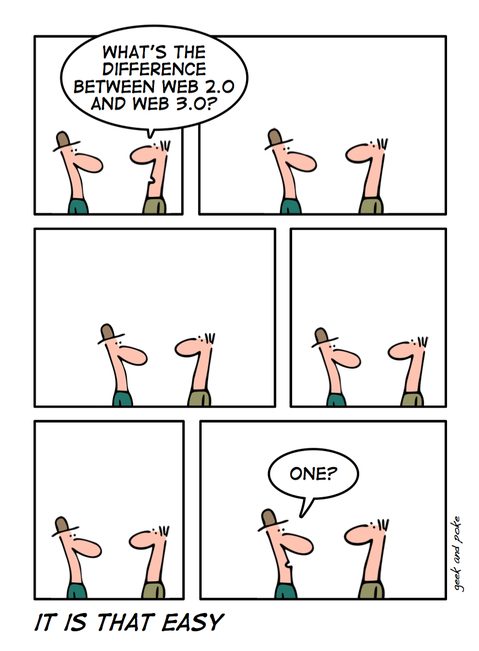End of the affair: How Web 2.0 data storage cannot compete with Web 3.0
In the early days of the internet, data storage was a simple affair. Full of promise and uncomplicated, it seemed like it would last forever.
Websites consisted of static pages and a few images, and the storage and retrieval of data was a relatively straightforward process. As the internet grew, however, so did the amount of data that needed to be stored and accessed. This led to the development of Web 2.0, a new way of storing and sharing data that revolutionized the internet.
Web 2.0 allowed for the creation of dynamic, interactive websites that could be updated in real time. Social media platforms, online marketplaces, and other web-based applications became possible, and the amount of data being generated and stored exploded. However, as powerful as Web 2.0 was, it had some serious limitations when it came to data storage. Enter Web 3.0, the next generation of the internet – or, the end of the affair.
One of the biggest limitations of Web 2.0 data storage is its centralized nature. In Web 2.0, data is stored on servers owned and controlled by large corporations such as Facebook and Google. This centralized approach to data storage has several drawbacks.
Firstly, it means that the data is vulnerable to hacking and other security breaches. If a hacker gains access to a company’s servers, they can potentially access vast amounts of sensitive data, including personal information, financial data, and more.
Secondly, it means that users have little control over their data. When you sign up for a social media account or use an online marketplace, you’re essentially agreeing to hand over your data to the company in question. This data can be used for a variety of purposes, including targeted advertising, and there’s often little transparency around how the data is being used.
Web 3.0, on the other hand, is built on decentralized data storage. Rather than being stored on centralized servers, data is stored across a network of nodes. This makes it much more difficult for hackers to gain access to large amounts of data, as there’s no central point of vulnerability.
Decentralized data storage also gives users more control over their data. Instead of handing it over to a single company, users can choose to store their data on a decentralized network and control who has access to it. This has the potential to give users greater privacy and security, and to reduce the power of large corporations over user data (Figure 1).
Figure 1: Centralised vs. decentralised
 Source: Holon
Source: Holon
Another key difference between Web 2.0 and Web 3.0 data storage is the use of blockchain technology. Blockchain is a decentralized ledger that allows for secure, transparent, and tamper-proof storage of data. It’s best known as the technology that underpins cryptocurrencies such as Bitcoin, but it has a wide range of potential applications beyond finance.
In Web 3.0, blockchain technology is being used to create decentralized applications (dapps) that can store and manage data in a secure and transparent way. These dapps are built on decentralized networks such as Filecoin, and they allow for a wide range of applications, from social media platforms to online marketplaces.
One of the key benefits of using blockchain for data storage is its transparency. Because blockchain is a decentralized ledger, anyone can see all the transactions that have taken place on the network. This makes it much more difficult for companies to manipulate data or engage in other shady practices.
Another benefit of blockchain is its tamper-proof nature. Once data is stored on the blockchain, it cannot be altered or deleted without the consensus of the network. This means that data stored on a blockchain is much more secure.
Using blockchain for data storage also means transparency. Because blockchain is a decentralized ledger, anyone can see all the transactions that have taken place on the network. This makes it much more difficult for companies to manipulate data or engage in other shady practices.
Blockchain is also considered tamper-proof. Once data is stored on the blockchain, it cannot be altered or deleted without the consensus of the network. This means that data stored on a blockchain is much more secure than data stored on centralized servers.
Decentralized data storage and blockchain technology are still in their early stages, and there are challenges to be overcome. One of the biggest challenges is scalability. Decentralized networks can struggle to handle large amounts of data, which can slow down or even crash the network. However, there are already solutions being developed to address these issues, such as sharding and layer 2 solutions.
“…Web 3.0 has the potential to give users greater control over their data, reduce the power of large corporations, and increase transparency and security.”
Another challenge is interoperability. With so many different decentralized networks being developed, there is a risk of fragmentation and a lack of standardization. However, efforts are being made to create interoperability between different networks, allowing for greater flexibility, ease of use, and greater collaboration and communication between decentralized applications.
By enabling decentralized data storage and management, Web 3.0 has the potential to give users greater control over their data, reduce the power of large corporations, and increase transparency and security.
This has important implications for a wide range of industries, from finance and healthcare to social media and e-commerce. Decentralized networks and dapps have the potential to create more democratic, equitable, and sustainable systems, and to transform the way we interact with data and each other.
 Source: Geek & Poke
Source: Geek & Poke
As we move towards a more decentralized and blockchain-based internet, it will be important to ensure that these technologies are developed and used in a responsible and ethical way. This means addressing issues of scalability, interoperability, and governance, and ensuring that users have the knowledge and tools they need to navigate these new systems.
It also means being mindful of the potential social and economic impacts of these technologies. While Web 3.0 has the potential to create more equitable and democratic systems, it is not a panacea. It is important to consider the potential unintended consequences of decentralization, such as the impact on employment and traditional institutions, and to work towards solutions that address these issues.
The affair was great while it lasted. Web 2.0 data storage has served us well for many years, but it has its limitations. The centralization of data has created vulnerabilities for hacking, censorship and cyber attacks, and has given large corporations too much control over user data. Web 3.0, with its focus on decentralized data storage and blockchain technology, promises to address these issues and create a more secure, transparent, and equitable internet.
While there are challenges to be overcome, the potential benefits of Web 3.0 are vast. By enabling decentralized data storage and management, it has the potential to transform the way we interact with data and each other, and to create more democratic, equitable, and sustainable systems. It is up to us to ensure that these technologies are developed and used in a responsible and ethical way, and to work towards a future that benefits us all. Like something a bit more permanent.
Disclaimer: This Article has been prepared by Holon Global Investments Limited ABN 60 129 237 592. Holon Global Innovations Pty Ltd (“HGI”) is a wholly owned subsidiary of Holon Global Investments Limited (together “Holon”). HGI is a Filecoin (FIL) Storage Provider and is positioned as a major player in the FIL decentralised data storage arena. FIL Storage Providers are rewarded in FIL for the provision of data storage capacity. Holon, its officers, employees and agents believe that the information in this material and the sources on which the information is based (which may be sourced from third parties) are correct as at the date of publication. While every care has been taken in the preparation of this material, no warranty of accuracy or reliability is given and no responsibility for this information is accepted by Holon, its officers, employees or agents. Except where contrary to law, Holon excludes all liability for this information.





